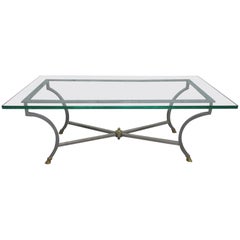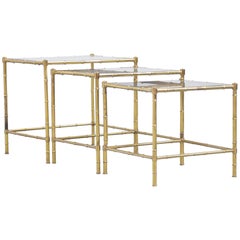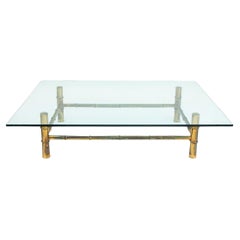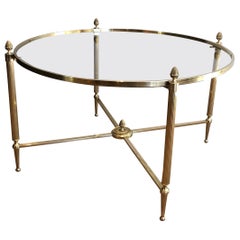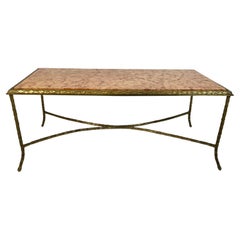Maison Bagues Coffee Table
Vintage 1950s French Directoire Coffee and Cocktail Tables
Brass, Steel
Early 20th Century French Coffee and Cocktail Tables
Faux Bamboo
Mid-20th Century French Coffee and Cocktail Tables
Bronze
Vintage 1960s French Mid-Century Modern Coffee and Cocktail Tables
Brass
Mid-20th Century French Mid-Century Modern Coffee and Cocktail Tables
Brass
Late 20th Century Coffee and Cocktail Tables
Metal
20th Century French Neoclassical Coffee and Cocktail Tables
Brass
Vintage 1960s French Hollywood Regency Coffee and Cocktail Tables
Brass
Vintage 1950s French Mid-Century Modern Coffee and Cocktail Tables
Marble, Bronze
Vintage 1960s French Mid-Century Modern Coffee and Cocktail Tables
Bronze
Mid-20th Century French Neoclassical Coffee and Cocktail Tables
Bronze, Nickel
Vintage 1940s French Neoclassical Coffee and Cocktail Tables
Brass
Vintage 1950s French Hollywood Regency Coffee and Cocktail Tables
Vintage 1980s French Directoire Coffee and Cocktail Tables
Steel
Mid-20th Century French Neoclassical Coffee and Cocktail Tables
Brass
Mid-20th Century Mid-Century Modern Coffee and Cocktail Tables
Nickel
Vintage 1940s French Neoclassical Coffee and Cocktail Tables
Brass
Vintage 1940s French Hollywood Regency Coffee and Cocktail Tables
Brass
Vintage 1940s French Louis XVI Coffee and Cocktail Tables
Brass
Mid-20th Century Unknown Hollywood Regency Coffee and Cocktail Tables
Bronze
20th Century Chinoiserie Coffee and Cocktail Tables
Bronze
Vintage 1940s French Louis XVI Coffee and Cocktail Tables
Bronze
Vintage 1940s French Hollywood Regency Coffee and Cocktail Tables
Bronze
Mid-20th Century French Mid-Century Modern Coffee and Cocktail Tables
Brass, Bronze
Vintage 1970s French Mid-Century Modern Coffee and Cocktail Tables
Brass, Metal
2010s Mid-Century Modern Coffee and Cocktail Tables
Metal
Vintage 1970s French Coffee and Cocktail Tables
Wood, Lacquer
Mid-20th Century Mid-Century Modern Coffee and Cocktail Tables
Iron, Gold Leaf
Mid-20th Century French Art Deco Coffee and Cocktail Tables
Bronze
20th Century Mid-Century Modern Coffee and Cocktail Tables
Bronze
Mid-20th Century French Mid-Century Modern Coffee and Cocktail Tables
Marble, Bronze
Vintage 1950s French Coffee and Cocktail Tables
Brass
20th Century Mid-Century Modern Coffee and Cocktail Tables
Brass, Bronze
Vintage 1980s French Directoire Coffee and Cocktail Tables
Steel
Vintage 1940s French Neoclassical Coffee and Cocktail Tables
Brass
Vintage 1950s French Neoclassical Coffee and Cocktail Tables
Bronze
Vintage 1950s French Neoclassical Coffee and Cocktail Tables
Bronze
Mid-20th Century French Neoclassical Coffee and Cocktail Tables
Brass
Vintage 1960s French Mid-Century Modern Coffee and Cocktail Tables
Metal, Brass
Vintage 1950s French Coffee and Cocktail Tables
Bronze
Vintage 1960s French Mid-Century Modern Coffee and Cocktail Tables
Brass
Mid-20th Century French Coffee and Cocktail Tables
Bronze
Early 2000s American Modern Coffee and Cocktail Tables
Metal
Vintage 1970s French Hollywood Regency Coffee and Cocktail Tables
Metal
Vintage 1950s French Mid-Century Modern Coffee and Cocktail Tables
Bronze
Vintage 1960s French Art Deco Coffee and Cocktail Tables
Bronze
Vintage 1970s Mid-Century Modern Coffee and Cocktail Tables
Brass
Mid-20th Century French Mid-Century Modern Coffee and Cocktail Tables
Bronze
Vintage 1960s French Neoclassical Coffee and Cocktail Tables
Brass
Vintage 1940s French Hollywood Regency Coffee and Cocktail Tables
Iron
Vintage 1930s French Art Deco Coffee and Cocktail Tables
Bronze
20th Century French Mid-Century Modern Coffee and Cocktail Tables
Bronze
Vintage 1940s French Mid-Century Modern Coffee and Cocktail Tables
Bronze
Mid-20th Century French Coffee and Cocktail Tables
Brass
Vintage 1940s French Coffee and Cocktail Tables
Brass
Vintage 1960s French Neoclassical Coffee and Cocktail Tables
Brass, Bronze
Early 20th Century French Coffee and Cocktail Tables
Brass
Mid-20th Century French Neoclassical Coffee and Cocktail Tables
Brass
- 1
- ...
Maison Bagues Coffee Table For Sale on 1stDibs
How Much is a Maison Bagues Coffee Table?
Finding the Right Coffee-tables-cocktail-tables for You
As a practical focal point in your living area, antique and vintage coffee tables and cocktail tables are an invaluable addition to any interior.
Low tables that were initially used as tea tables or coffee tables have been around since at least the mid- to late-1800s. Early coffee tables surfaced in Victorian-era England, likely influenced by the use of tea tables in Japanese tea gardens. In the United States, furniture makers worked to introduce low, long tables into their offerings as the popularity of coffee and “coffee breaks” took hold during the late 19th century and early 20th century.
It didn’t take long for coffee tables and cocktail tables to become a design staple and for consumers to recognize their role in entertaining no matter what beverages were being served. Originally, these tables were as simple as they are practical — as high as your sofa and made primarily of wood. In recent years, however, metal, glass and plastics have become popular in coffee tables and cocktail tables, and design hasn’t been restricted to the conventional low profile, either.
Visionary craftspeople such as Paul Evans introduced bold, geometric designs that challenge the traditional idea of what a coffee table can be. The elongated rectangles and wide boxy forms of Evans’s desirable Cityscape coffee table, for example, will meet your needs but undoubtedly prove imposing in your living space.
If you’re shopping for an older coffee table to bring into your home — be it an antique Georgian-style coffee table made of mahogany or walnut with decorative inlays or a classic square mid-century modern piece comprised of rosewood designed by the likes of Ettore Sottsass — there are a few things you should keep in mind.
Both the table itself and what you put on it should align with the overall design of the room, not just by what you think looks fashionable in isolation. According to interior designer Tamara Eaton, the material of your vintage coffee table is something you need to consider. “With a glass coffee table, you also have to think about the surface underneath, like the rug or floor,” she says. “With wood and stone tables, you think about what’s on top.”
Find the perfect centerpiece for any room, no matter what your personal furniture style on 1stDibs — shop Art Deco coffee tables, travertine coffee tables and other antique and vintage coffee tables and cocktail tables today.
Read More
20 Inviting Dining Rooms Perfectly Arranged for Entertaining
Top interior designers show — and tell — us how to create delectable spaces for hosting dinner parties.
This Alain Delon–Designed Table Is Almost as Handsome as He Was
Fans of the French film star may be surprised to learn that he had a flair for furniture with sleek lines and disco-era flash.
Uchronia’s Plant Stand Gives Pots a Pretty Perch with All the Trimmings
Like other pieces in the firm’s Candy Box collection, the cheerful limited-edition design showcases French craft.
The Ultimate Guide to Types of Tables for the Home
Whether you’re just moving in or ready to give your home a makeover, our guide will give you pointers on tables that are fitting for every room, nook and hallway.
Is Lionel Jadot the Willy Wonka of Upcycled Belgian Design?
From his massive collaborative workshop in a former paper factory, the designer concocts funky furniture from disused materials, as well as luxe hotel interiors like the new Mix Brussels.
Inspired by the Cosmos, Sandra Nunnerley’s Nova Table Has a Futuristic Feel
The designer’s innovative use of an unexpected material gives this console a lift.
This 19th-Century Gilded Desk Displays a Fanciful Kingdom in Marquetry
The stately piece brings both gravitas and whimsy to any work space.
In Guadalajara, These Luscious Side Tables Are Chiseled from Volcanic Rock
Use them as tables or stools, indoors or out.
